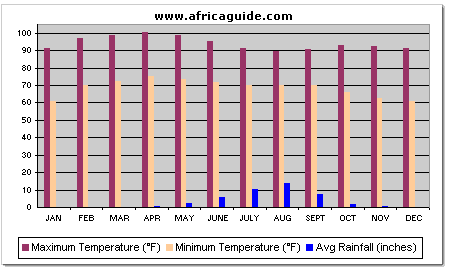Mali Visitor Information
Parent page
On this page
Mali is made up of two climatic regions, Sudanese and Sahelian, with the city of Keyes roughly the meeting point. Average annual rainfall in the south of the Sudanese regions is about 55 inches and in the north, where it borders the desert, only 8 inches. In the Sahelian region there are considerable variations of temperature, especially in April, May and June, the period of maximum heat, and in December, when the hot, dry harmattan blows. The average temperature is 30°C (86°F). Continuing north through the Sahelian regions, one gradually enters into a Saharan climate marked by the virtual absence of rain and an extremely dry atmosphere. Over 40% of the country is, in fact, desert, and unsuitable for agriculture. The year is divided into three main seasons varying in length according to the latitude: November - February, cool and dry; March to May, hot and dry; and June to October, a season of rains characterised by lower temperatures and an increase in humidity.
Visas are required by all visitors except nationals of Algeria, Benin, Burkina Faso, Cameroon, Chad, Ivory Coast, Guinea, Mauritania, Morocco, Niger, Senegal, Togo and Tunisia provided you are in possession of a valid ID. Passports must be valid for at least 3 months from the date of entry.
Embassies do NOT always update us when they change their entry requirements - we strongly advise you contact your nearest embassy to find our the lastest information.
Mali Embassies and/or Consulates located around the world
Official Currency: Communaute Financiere Africaine franc
Current Exchange Rate: Today's Exchange Rate
Travellers cheques can be exchanged at banks. Commission rates are vary depending on currency and are in some cases can be quite high. Only a few international hotels in the Bamako accept credit cards. Cash advances are only available from BMCD. Banks are notoriously slow in processing transactions.
Air
Domestic flights are available between Bamako and Gao via Mopti and Timbuktu.
River
During the raining season between August and November large passenger boats operate a passenger service on the Niger River. A weekly service runs between Koulikoro and Gao, via Mopti, Kabara and Timbuktu. The journey from Koulikoro to Mopti should take 3 days and from Mopti to Goa four days. Do not limit yourself on time as very often it takes longer. First class cabins are available but need to be booked in advance. Pirogues (canoes) can also be hired between Timbuktu and Mopti. Between December and March, when water levels are low, it may only be possible to travel between Mopti and Gao.
Bus
A reasonable bus services run between all the main towns. On shorted route bush taxis operate and are cheaper than buses.
Road
Roads in Mali are in a poor state and on main roads there are many police and customs checkpoints, many of them corrupt and looking for a bribe. Between Mopti and Gao travel is slow and difficult during the raining season.
Driving is on the right hand side and and International driving licence is recommended although not a requirement. There are a few Car Hire companies in Bamako.
1st January - New Year's Day
20th January - Armed Forces Day
1st May - Labour Day
25th May - Africa Day
7th July - Prophet's Birthday
6th August - Baptism of the Prophet
22nd September - Independence Day
25th December - Christmas Day
Variable holidays: East Monday and Islamic holidays
Electric Power is 220V - 240V running at 50Hz.
The Plug type used in Mali is: "Type C, E & F"


